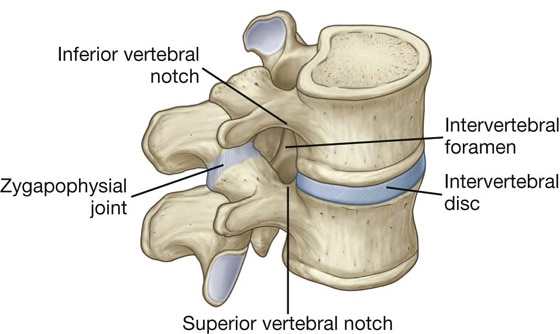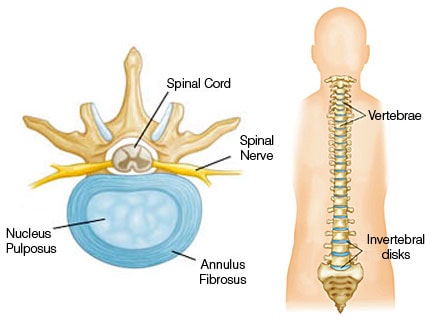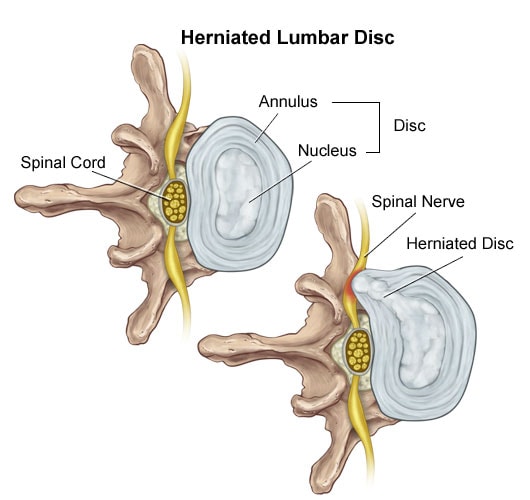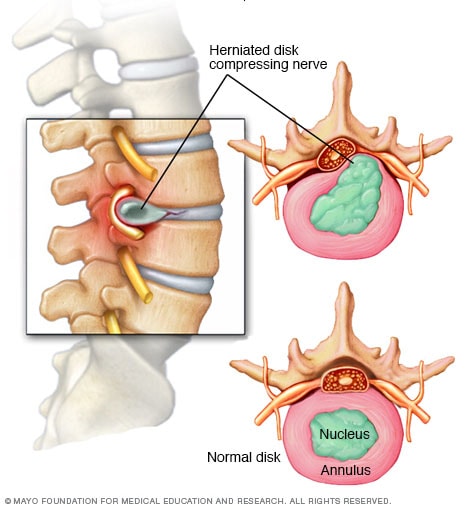The intervertebral disc (IVD) is situated between each vertebra of the spinal column. However, there is no disc between the first two vertebrae of the neck or within the segments of the coccyx. The IVD is a fibrocartilaginous cushion serving as the spine’s shock-absorbing system. It also assists in the fluid motion of the spine in flexion and extension. Spinal nerves exit between two vertebral segments of the spine through what is called the intervertebral foramen. The spinal nerves supply all the tissues of the body.

The IVD is composed of two major layers including the annulus fibrosis and the nucleus pulposus. The annulus is the tough, outer layer of the IVD and is made up of concentric layers of collagen fibers oriented at varying angles. It surrounds the nucleus, which has a higher content of water than the annulus. Therefore, the IVD is like a jelly donut with the annulus acting as the dough and the nucleus acting as the jelly. The IVD can be a source of pain within the spine or extremities depending on the nature of the injury or episode.

Injury to the IVD is very often the result of years of repetitive stress to the neck or back. It will then only take a minor traumatic event to cause frank injury to the disc. First, there is usually the tearing of the annular fibers that occur from the inside-out. This can be visualized on an MRI but not on a routine X-Ray. This tearing can allow the nucleus to bulge outward into the spinal canal or into the intervertebral foramen where the spinal nerves exit. The annulus can also completely tear leading to herniation of the nuclear material into the spinal canal or intervertebral foramen.

Bulging or herniation of the IVD into the intervertebral foramen can put pressure on or cause irritation to the spinal nerves. When this occurs it can cause local pain in the region or more commonly radiating pain into the arms or legs. If the injured disc is in the neck or cervical spine it can cause shooting pain, numbness, tingling or burning sensations into the arms, commonly a specific region of the arm. If the injured disc is in the lower back or lumbar spine it can cause these symptoms into the legs. Patients will often also notice weakness in the arms or legs because the spinal nerves innervate the muscles, which allows for precise motor control.

There are several conservative treatments available for intervertebral disc syndromes. The idea is to take the pressure off of the irritated nerve and decrease pain. This can be accomplished by both manual and mechanical traction, otherwise known as spinal decompression. Traction includes stretching the spinal column taking the pressure off of the discs and the nerves. Spinal manipulative therapy is often effective in decreasing pain associated with joint dysfunction that can occur due to an injured disc. Physiological therapeutic modalities such as electrical muscle stimulation and ice may also be used to decrease muscle spasms and decrease pain.
Rehabilitative exercises are paramount in order to relieve pressure from the nerves and strengthen spinal stabilizing musculature. Finally, natural anti-inflammatory supplements may be prescribed to help decrease inflammation caused by the injured IVD. For those patients that do not respond favorably to conservative management, spinal injections or surgical options are also available.
We have the following treatments:
- Chiropractic Manipulative Therapy & Adjustments
- Functional Soft Tissue Therapies: Active Release Technique, Graston Technique, & FAKTR
- Kinesio Taping
- Spinal Decompression Therapy
- And more…
Of course, a thorough evaluation by your healthcare professional is required in order to properly diagnose intervertebral disc syndromes. Call us now or reach out to us by filling out the form below. If you are looking to get evaluated visit our Chiropractor NYC area to learn more!
In Physiologic, Our priority is your well-being